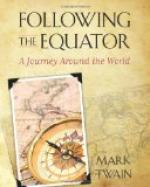A few miles down the mountain we stopped half an hour to see a Thibetan dramatic performance. It was in the open air on the hillside. The audience was composed of Thibetans, Ghurkas, and other unusual people. The costumes of the actors were in the last degree outlandish, and the performance was in keeping with the clothes. To an accompaniment of barbarous noises the actors stepped out one after another and began to spin around with immense swiftness and vigor and violence, chanting the while, and soon the whole troupe would be spinning and chanting and raising the dust. They were performing an ancient and celebrated historical play, and a Chinaman explained it to me in pidjin English as it went along. The play was obscure enough without the explanation; with the explanation added, it was (opake). As a drama this ancient historical work of art was defective, I thought, but as a wild and barbarous spectacle the representation was beyond criticism. Far down the mountain we got out to look at a piece of remarkable loop-engineering—a spiral where the road curves upon itself with such abruptness that when the regular train came down and entered the loop, we stood over it and saw the locomotive disappear under our bridge, then in a few moments appear again, chasing its own tail; and we saw it gain on it, overtake it, draw ahead past the rear cars, and run a race with that end of the train. It was like a snake swallowing itself.
Half-way down the mountain we stopped about an hour at Mr. Barnard’s house for refreshments, and while we were sitting on the veranda looking at the distant panorama of hills through a gap in the forest, we came very near seeing a leopard kill a calf.—[It killed it the day before.] —It is a wild place and lovely. From the woods all about came the songs of birds,—among them the contributions of a couple of birds which I was not then acquainted with: the brain-fever bird and the coppersmith. The song of the brain-fever demon starts on a low but steadily rising key, and is a spiral twist which augments in intensity and severity with each added spiral, growing sharper and sharper, and more and more painful, more and more agonizing, more and more maddening, intolerable, unendurable, as it bores deeper and deeper and deeper into the listener’s brain, until at last the brain fever comes as a relief and the man dies. I am bringing some of these birds home to America. They will be a great curiosity there, and it is believed that in our climate they will multiply like rabbits.
The coppersmith bird’s note at a certain distance away has the ring of a sledge on granite; at a certain other distance the hammering has a more metallic ring, and you might think that the bird was mending a copper kettle; at another distance it has a more woodeny thump, but it is a thump that is full of energy, and sounds just like starting a bung. So he is a hard bird to name with a single name; he is a stone-breaker,




